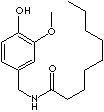PRODUCT IDENTIFICATION

H.S. CODE
TOXICITY
PRICE
U$1,100.-
by courier for 5kgs
U$2,100.-
by courier for 1kg
CLASSIFICATION
PHYSICAL AND CHEMICAL PROPERTIES
AUTOIGNITION
NFPA RATINGS
REFRACTIVE INDEX
Stable under ordinary conditions.
APPLICATIONS
Capsaicin is a compound that gives food the hot sensation. It is the most common of capsaicinoids, followed by dihydrocapsaicin, found in capsicum family of plants, which rises the heat of chillies. Other capsaicinoids present in the Capsicum fruit include nordihydro-, homo-, homodihydro-, nor-, and nornorcapsaicin. Capsaicin is the major flavouring compound, whereas capsanthin and capsorubin are major colouring compounds among variety of coloured compounds present in chile peppers. The chemical designation of capsaicin is N-vanillyl-8-methyl-6-(E)-noneamide. Capsaicin is a lipophilic white crystalline powder; melting point 60 - 65 C. Capsaicin, as a member of the vanilloids, desensitizes the sensory nerve endings giving a paradoxical antinociceptive effect. Capsaicin does not actually cause a chemical burning but a burning sensation . When nociceptors contact with capsaicin, the neuron is excited to sign the perception of pain, and there is a local release of inflammatory mediators. Capsaicin is used in food products to give strong spice or piquancy. It is used in cream as a paradoxical counterirritant and topical analgesic ingredient to relieve the pain of peripheral neuropathy. Capsaicin is also used to dispel insects and animals. It is used as pepper spray or tear gas similarly. Vanilloids are a group of compounds which are related to capsaicin structurally. It is known they demonstrate actions via the vanilloid receptor which is a subgroup of TRP (transient receptor potential) cation channels, very sensitive to temperature and hot spicy food and capsaicin.
Members of vanilloid include:
|
Product |
CAS RN |
|
N-Oleoyldopamine |
105955-11-1 |
|
Ruthenium Red |
11103-72-3 |
|
Arvanil |
128007-31-8 |
|
Capsazepine |
138977-28-3 |
|
Phorbol 12-phenylacetate 13-acetate 20-homovanillate |
175796-50-6 |
|
Dihydrocapsaicin |
19408-84-5 |
| (all Z)-N-(4-Hydroxyphenyl)-5,8,11,14-eicosatetraenamide | 198022-70-7 |
|
N-Arachidonoyldopamine |
199875-69-9 |
|
N-Vanillylnonanamide |
2444-46-4 |
|
(Z)-Capsaicin |
25775-90-0 |
|
1-(2-Hydroxyphenyl)-4-(3-nitrophenyl)-1,2,3,6-tetrahydropyrimidine-2-one |
36945-98-9 |
|
Isovelleral |
37841-91-1 |
|
(E)-Capsaicin |
404-86-4 |
|
Resiniferatoxin |
57444-62-9 |
|
Olvanil |
58493-49-5 |
|
Anandamide |
94421-68-8 |
|
Iodoresiniferatoxin |
n/a |
|
6-Iodonordihydrocapsaicin |
n/a |
|
4'-Chloro-3-methoxycinnamanilide |
n/a |
|
6'-Iodoresiniferatoxin |
n/a |
APPEARANCE
CONTENT
96.0% min
WATER
1.0% max